The placename Osterode can refer to:
- Osterode (district), district in Germany
- Osterode am Harz, town in Lower Saxony, Germany
- Osterode, Harztor, village in Thuringia, Germany
- Ostróda (Osterode in Ostpreußen), town in Poland
The placename Osterode can refer to:
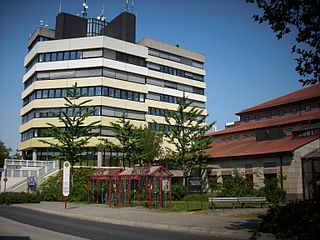
Northeim is a district in Lower Saxony, Germany. It is bounded by the districts of Holzminden, Hildesheim, Goslar and Göttingen, and the state of Hesse.

Göttingen is a district in Lower Saxony, Germany. It is bounded by the districts of Northeim and Goslar, and by the states of Thuringia and Hesse. The capital is the university city of Göttingen.

Osterode was a district in Lower Saxony, Germany. It was bounded by the districts of Göttingen, Northeim and Goslar, and by the state of Thuringia.

Ostróda is a town in northern Poland, in the historic region of Masuria. It is the seat of the Ostróda County within the Warmian-Masurian Voivodeship and has approximately 33,191 inhabitants (2009).
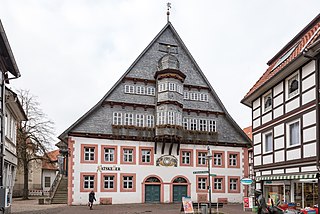
Osterode am Harz, often simply called Osterode, is a town in south-eastern Lower Saxony in central Germany on the south-western edge of the Harz mountains. It was the seat of government of the district of Osterode. Osterode is located on the German Timber-Frame Road.
Herzberg is German for "heart mountain" and may refer to:
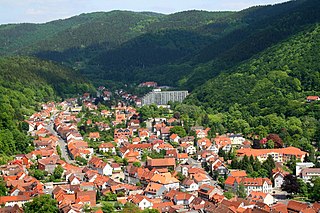
Bad Lauterberg is a town in the district of Göttingen, in Lower Saxony, Germany. It is situated in the southern Harz, approx. 15 km southwest of Braunlage, and 20 km southeast of Osterode am Harz.
Steinau can refer to:

Olsztynek is a town in northern Poland, in Olsztyn County, in the Warmian-Masurian Voivodeship. It is the administrative seat of Gmina Olsztynek. It is part of the historic region of Masuria.
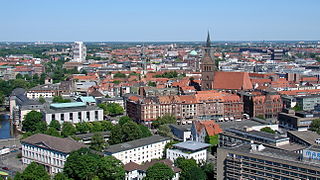
The Hanover–Braunschweig–Göttingen–Wolfsburg Metropolitan Region is an economic and cultural region in Northern Germany. The metropolitan region comprises approximately one third of the area of Lower Saxony, with almost half the inhabitants of the state. It has about 3.9 million people in 20 districts and counties with a total of 431 municipalities and is defined by the German Ministerkonferenz für Raumordnung (MKRO) as a medium urban area in Germany.

Söse is a river of Lower Saxony, Germany. It is a right tributary of the river Rhume and 38 kilometres (24 mi) long.
The Liesgau was a shire (Gau) of the Duchy of Saxony in the early medieval period, roughly corresponding to the former Osterode district of Lower Saxony. It was situated on the south-west side of the Harz Mountains in what is now the German state of Lower Saxony. Its southern bound was near the town of Duderstadt and its northern bound near Osterode, and its western bound near the River Leine. Its eastern boundary corresponds to the present-day eastern border of Lower Saxony.
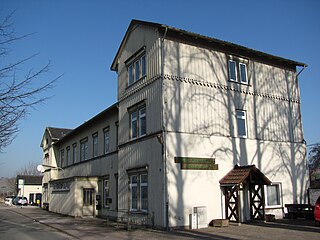
The Herzberg–Seesen railway, also known as the West Harz Line, is a 32 km long railway line, that runs along the western edge of the Harz mountains and serves the town and the district of Osterode am Harz. It is the shortest link from Brunswick to Erfurt and is worked today by Lint multiples from Brunswick via Salzgitter, Seesen and Osterode to Herzberg mainly at hourly intervals. In Herzberg there are connexions to Göttingen and Nordhausen.

The B 243 runs from Hildesheim over Seesen and Herzberg am Harz to Nordhausen.

The Apenke is a left tributary of the Söse in Osterode in the Harz Mountains in the German state of Lower Saxony.
Liechtenstein is a country in Europe.

The administrative district (Verwaltungsbezirk) of Harz is an unincorporated area in the German district of Göttingen. Until the merger of the old districts of Osterode am Harz and Göttingen, it was known as "Harz ".

Goslar – Northeim – Göttingen II is an electoral constituency represented in the Bundestag. It elects one member via first-past-the-post voting. Under the current constituency numbering system, it is designated as constituency 52. It is located in southern Lower Saxony, comprising most of the districts of Goslar, Northeim, and the former Osterode.

Frauke Heiligenstadt is a German politician of the Social Democratic Party who has been serving as a member of the Bundestag since 26 October 2021. She was a member of the Lower Saxony state parliament from 2003 to 2021, and Lower Saxony's Minister of Education from 2013 to 2017.